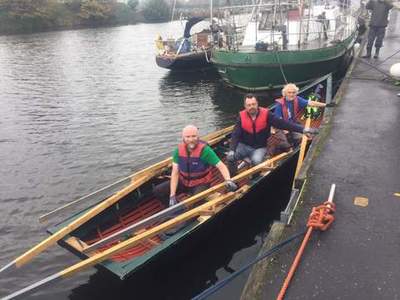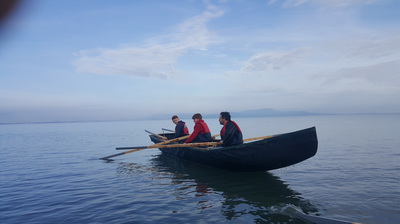There was a push on last week to complete a second set of oars after finding that the newly planed oars from the week before had worked a treat, and with two 21ft currachs on the trailer, we set off up the road to Annagassan to catch the tide before it turned. Using a, by now, well-rehearsed routine of lifting the boats, in no time at all the currachs were sitting on the silky sand that is sheltered by the north wall which extends from the harbour. The abandoned jeeps and cars parked abruptly along the pier seem to look at us hinting that we were late for work as all the boats had left the port two hours before. But our plan was simple and our destination, I thought, was the orange buoy that marks safe entry for the trawlers return. A lot of work over the past year and a lot of mistakes now rectified were all converging and culminating into this very moment when the sun shone and the sea breeze had all but disappeared. The first currach slipped off the beach after two youngsters volunteered, smiling and slagging at my elderly posture as they went. I dare not enter their space today. Instead I just attempt to read their thoughts of postures a far. And then there it was, like a white swan’s first truly independent flight, the oars rolled together like the wings of changelings and the sound of laughter could be heard from a far. Quickly we slipped the second craft into the water and with oars out stretched; we made haste to follow the track across the ebbing tide in an attempt to keep this moment for ever to ourselves. This time last year was so much different: the crew was younger; the oars were so much heavier for their arms; the sea was unforgiving with North East winds so up the estuary we had to go with arguments, it felt, on every bend and turn, as oars clashed and tempers flew. It was only for the swimming dog’s antics alongside that occasionally helped change the mode. But this time was so different, by the time we had rounded the buoy and parked on the carpet of seaweed, the other lads had turned up. Now there were three rowers for each of the currachs and a passenger for crew change. The local men, we had met over the summer while doing sea trials with the leather boat, stood by the rails to see us off. “We made a few ourselves a while ago after a visit to the undertakers”, one of them remarked. I was totally confused. “For the wooden latts”, he added when he saw the bewilderment in my face, “they are already cut to the right size”. On returning to the currach, I wasn’t sure what I was getting into!
The orange buoy, for the first time, had become a chain that was welcomingly broken and off over bay to Salterstown, the currachs shot, where a little pier juts out of the rocks. Our currach was still on trial and we found that with a passenger, it could pull to the left but the oars were great and it seemed to entertain a seal as we went. By the time we reached the other side, the lads were keen to slag our meandering ways and disorientated from their verbal grief, I crunched the last out of my neck to spot the seal again. But now it appeared in front of the boat and close to us as we rowed to a sudden stop. It began to talk, it was a round headed swimmer. I wasn’t sure at first but on looking over, the rocks were full of them getting a Sunday dip on the last weekend before November. Round to the beach we rowed and filled the faces, then before another word was said, we robbed the other currach for the return journey, leaving passenger behind, and then we beat up against the tide to watch with glee their slow and sluggish meanderings.
Still a lot of work to do with the third set of oars, they have to be planed down, and the slipped canvas on the third boat needs sewing from last year. So is it worth it after nearly four hours of rowing? The answer would have to be “Yes! Every minute!”


